
|
American Logo
|
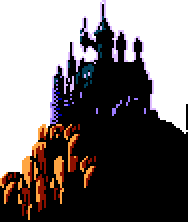 |
Japanese Logo
|
 |
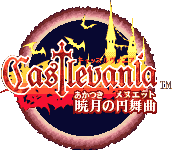 |
|
|
|
|
| . | . | . | ||
|
General
Information
|
||||
|
|
||||
| Date Released: 2003 |
|
Heroes: Soma Cruz | Secret: Julius Belmont | ||
|
|
||||
| Stage Number: 13 Castle Sections |
|
Size: 8MB | ||
|
|
||||
|
Original
System(s)
Game Boy Advance (GBA) |
||||
|
|
||||
|
Ported
To
Cell Phones |
||||
|
Alternate
Names/Systems
Castlevania: Akatsuki no Minuet -- translation: Castlevania: Minuet of Dawn (Japan) |
||||
|
Re-release Information (1) 2005: Re-released
in Japan as part of Konami's GBA "The
Best" series |
||||
|
|
||||
|
Manual Story Description The year is 2035. Japan. Crowds of spectators are gathering around in anticipation of the first full solar eclipse of the 21st century. My name is Soma Cruz and I am a high school exchange student studying abroad in Japan. I live near the Hakuba Shrine, an ancient shrine with strong ties to Japanese mythology. Mina Hakuba, the only daughter of the shrine's caretaker, is both my classmate and my childhood friend. I started making my way to the shrine to see the solar eclipse with Mina. But, for some strange reason, the stairway leading up to the shrine felt longer than usual, as if something was trying to keep us from our destination. When I finally managed to get through the shrine gate, my senses began to dim. In the distance, the solar eclipse was approaching totality, but the pitch black sun appeared to be trapping chaotic darkness. At that moment, Mina and I were knocked unconscious - only to awaken inside a mysterious castle. Now I must find a way out of this labyrinth and escape safely with my friend. |
||||
|
|
||||
|
Objective/Overview While creating Harmony of Dissonance, KCET was so sure of its success that the production of the division's next title was already ongoing. So in timely fashion, it brings to you Castlevania: Aria of Sorrow, yet another free-roaming adventure-RPG in the vein of the award-winning Symphony of the Night; this latest GBA entry, as you'd suspect from the timing, closely emulates the previous Harmony but corrects many of its deficiencies. You're this time in control of Soma Cruz, a seemingly ordinary young man, and you must guide him through thirteen castle sections--each crowded with Aria's brand of minor enemies, twisted traps, and menacing boss creatures--in a quest to discover his true self, to gain insight into his so-called friends' intentions, and to escape from the thought-banished Castlevania. Soma starts out with only a weak knife and his fists, so you'll have to empower our hero using the RPG system, which can be manipulated through the gaining of levels, through the collection of dozens of new weapons and armor types, and through the use of inventory-held magical items. Moreover, you can take advantage of Soma's natural ability to steal souls and therein gain three types of soul power: Bullet (sub-weapons); Guardian (helpers); Enchanted (body enhancers); and Ability (relic-like powers such as sliding, double jumping and dashing). How you go about reaching the final destination will earn you one of three different endings. Once you complete the game, having received the best ending, more options will open up: (1) You can play through the game on a "hard" mode. (2) You can play as Julius Belmont. (3) The "Boss Rush" mode returns, this time a single-gauntlet challenge that pits you against all of the game's bosses; this time around, you can select your main mission file and carry along all of your collected weapons, souls and items. You can play through it with Julius, too, in his own special manner. And (4) you can access a sound test. |
||||
|
Port Differences Cell Phones: (1) There's no opening dialogue between Mina and Arikado, nor is there any conversation when the first of the souls is absorbed; character encounters are instead briefly "described" via narration. (2) Several areas have been removed; this is reflected in the game's map. (3) The soundtrack features only four area themes (Castle Corridor, Chapel, Study and Underground Reservoir), which substitute for even boss fights and sequences. (4) There are no doors separating the castle areas; musical changes are your only cue. (5) A large number of equippable weapons are missing. (6) Liberty is taken in that level design from one area is sometimes recycled in another (likely for space-saving), which creates incongruity between this and GBA version and overall player confusion. (7) There is only one final boss--Graham's second form; to breach the final room and initiate this battle requires the collection of the three Ancient Books. (8) There are only two bosses game-wide (the Creaking Skull and the aforementioned Graham Jones). (9) Mandatory "Ability Souls," like the double jump, are found simply laying in the open, as almost all of their former boss guardians are missing. And (10) the ending is abbreviated. (Thanks to ReyVGM for this information.) |
||||
|
|
||||
|
Japanese/European Differences All versions of Aria of Sorrow are identical to each other in mechanics, in palette, in play control, and in extras. The only difference, as usual, is the deviations in the names. In this case, J, whose full name is revealed to be Julius Belmont, is named in the usual Japanese style--that is, his name is instead Julius Belmondo. Soma is "Kurusu Souma." Also, Lubicant should be called "Rubicant" (as in Final Fantasy's own), which shows that some name-changes are more a product of mistranslation. In that vein, many of the enemy characters use their true Japanese names rather than the adopted names used in the American version of Symphony of the Night and its ilk. For instance: Thornweeds are actually called "Unes" and Lossoths are now "Biphrons." The only notable change is in that of its story, in which Kurusu Souma is instead a man of Japanese descent rather than "an exchange student from Japan." Koji Igarashi explained that he made this change to the character's profile in order to better acclimate him to western audiences. |
||||
|
Soundtrack and Credits Soundtrack Links |
||||
|
|
||||
|
Other Characters Lesser Enemies:
Bat, Zombie, Skeleton, Merman, Axe Armor, Skull Archer, Peeping Eye,
Killer Fish, Bone Pillar, Blue Crow, Buer, White Dragon, Zombie Soldier,
Skeleton Knight, Ghost, Siren, Tiny Devil, Durga, Rock Armor, Giant
Ghost, Winged Skeleton, Minotaur, Student Witch, Arachne, Fleaman, Evil
Butcher, Quezlcoatl, Ectoplasm, Catoblepas, Ghost Dancer, Killer Doll,
Waiter Skeleton, Zombie Officer, Wooden Golem, Tsuchinoko, Persephone,
Lilith, Nemesis, Kyoma Demon, Chronomage, Valkyrie, Witch, Curly, Altair,
Red Crow, Cockatrice, Dead Warrior, Devil, Imp, Werewolf, Gorgon, Disc
Armor, Golem, Gremlin, Harpy, Medusa Head, Bomber Armor, Lightning Doll,
Une, Giant Worm, Needles, Man-Eater, Fish Head, Nightmare, Triton, Slime,
Dryad, Poison Worm, Arc Demon, Cagnazzo, Ripper, Ball of Destruction,
Werejaguar, Ukoback, Alura Une, Biphron, Mandragora, Flesh Golem, Sky
Fish, Dead Crusader, Kicker Skeleton, Weretiger, Killer Mantle, Mudman,
Gargoyle, Red Minotaur, Beam Skeleton, Alastor, Skull Millione, Giant
Skeleton, Gladiator, Bael, Succubus, Mimic, Stolas, Erinys, Lubicant,
Basilisk, Iron Golem, Demon Lord, Final Guard, Flame Demon and Shadow
Knight |
||||
|
|
||||
|
Character Lists |
||||
| . | . | . | ||
![]()
|
Hero
Image
|
Statistics
|
|
|
|
Full Name: Soma Cruz | |
| Main Weapon: Fists and a Knife | ||
| Weapon Power-Up: Click here for Soma's comprehensive list | ||
| Alternate Weapons: Click here for Soma's comprehensive list | ||
| Sub-Weapon Power-Up: Click here to see Soma's bullet souls | ||
| Special Abilities: Can back-dash, slide, double jump, jump kick, super jump, and transform/gain other powers via his collected souls | ||
| Armor: Click here for Soma's comprehensive list | ||
|
Hero
Image
|
Statistics
|
|
|
|
Full Name: Julius Belmont | |
| Main Weapon: Vampire Killer Whip | ||
| Weapon Power-Up: None | ||
| Alternate Weapons: None | ||
| Sub-Weapon Power-Up: None | ||
| Special Abilities: Can double jump, slide, circle dash--on the ground and in the air--super jump, jump kick and brandish the whip | ||
| Armor: None | ||
| Limitations: As a secret character, Julius is free to go almost everywhere with no restriction. In simple terms, Julius very much emulates a fully-powered Juste Belmont from Harmony of Dissonance. He moves much more quickly than Soma and performs well-controlled jumps. However, his is the more traditional arsenal: He uses the Vampire Killer whip as his main weapon, and he can swing it left and right and even utilize a brandishing technique; if he whips while jumping, he'll be forced to commit to that direction. Additionally, Julius can switch between four available sub-weapons--an axe, holy water, a boomerang and a special cross--that are powered by magic rather than hearts (collected hearts instead restore the magic meter). Julius, of course, can use all of the Juste and Soma special moves from the start: The double and super jumps for easy accessibility, a slide and a unique dash/dodge move for skilled combat, and a jump kick for a quick air assault to complement the whip. The only negative is that Julius has no stat-potential, so he can't become stronger or more equipped to deal with tougher enemies through normal means; instead, he'll have to defeat bosses and collect the crystals in order to become stronger and attain better defense. |
|
Weapon
Name
|
Weapon
Image
|
Description
|
|
Fists
|
|
Without
a weapon equipped, Soma will rely on short jabs
|
|
Knife
|
|
Soma
begins the game with a short knife used for quick stabs
|
|
Vampire
Killer
|
|
Ancient
steel-enhanced whip of the Belmont clan
|
![]()
|
Magical
Items
|
|||
|
Item Name
|
Image
|
Found In
|
Usage
|
|
Heart
|
|
Candle, Structure
|
Restores Magic
Power
|
|
Big Heart
|
|
Candle, Structure
|
Restores Magic Power
|
|
Coin
|
|
Candle, Structure
|
Currency
|
|
Money Bag
|
|
Laying Around
|
Currency
|
|
Crystal
|
|
Boss Creature
|
Clears Room/Restores
Stats
|
![]()
|
Sub-Weapons
|
|||
|
Weapon
Name
|
Image
|
Magic Consumption
|
Comments
|
|
Holy Water
|
|
25MP
|
Julius Only
|
|
Boomerang
|
|
50MP
|
Julius Only
|
|
Axe
|
|
25MP
|
Julius Only
|
|
Cross
|
|
200MP
|
Julius Only
|
![]()
Screenshots/Media
Local Title Screens
 |
 |
|
U.S.
Title Screen
|
.
|
Japanese Title
Screen
|
Action Shots


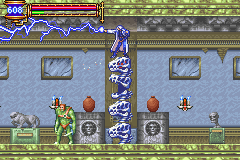

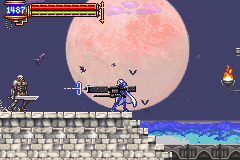


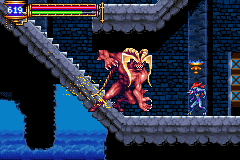
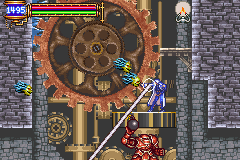
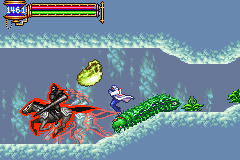
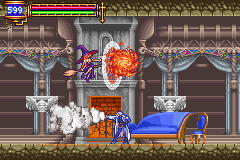
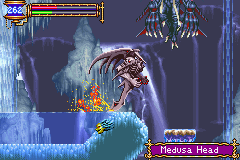

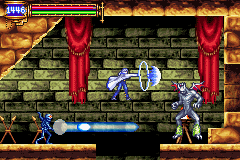
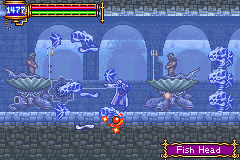
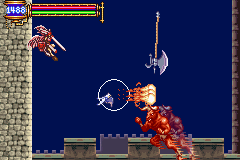
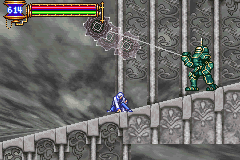

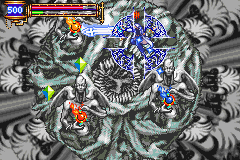
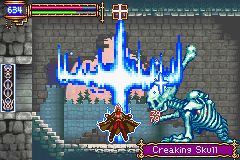
|
Quick-Reference
Links
|
||
|
Category
|
Availability
|
What's
Inside
|
|
Stages:
|
A look at
the thirteen castle areas and what's found in each
|
|
|
Review:
|
I look at
how this third GBA title compares to the two previous
|
|
|
Codes:
|
"Boss
Rush" Mode in detail | Castle Map | Name-Entry Codes
|
|
|
Magazine
Coverage
|
|
|
Item Name
|
Description
|
|
The official Japanese
guidebook featuring maps, strategies and more
|
|
|
Shown are the front
and back magazine covers plus select page samples
|
|
Text Documents
and Help Files
|
||
|
Walkthroughs
|
FAQs
|
Other Files
|
|
-
|
||
|
-
|
-
|
|
|
-
|
-
|
|
|
Scenes,
Packaging Scans and More
|
||
|
American
Version
|
Japanese
Version
|
European
Version
|
|
-
|
||
|
-
|
||
|
-
|
-
|
|
|
-
|
-
|
|
|
-
|
-
|
|
|
-
|
-
|
|
|
-
|
-
|
|
|
[Home] [What's New?] [CV Library] [Stages] [Reviews] [Weapons] [Castleography] [Multimedia] [Codes] [Links] |
||||